
Chennakesava Temple
Encyclopedia
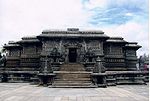
.jpg)
Hoysala Empire
The Hoysala Empire was a prominent South Indian Kannadiga empire that ruled most of the modern day state of Karnataka between the 10th and the 14th centuries. The capital of the Hoysalas was initially located at Belur but was later moved to Halebidu....
. Belur is 40 km from Hassan city and 220 km from Bangalore
Bangalore
Bengaluru , formerly called Bengaluru is the capital of the Indian state of Karnataka. Bangalore is nicknamed the Garden City and was once called a pensioner's paradise. Located on the Deccan Plateau in the south-eastern part of Karnataka, Bangalore is India's third most populous city and...
, in Hassan district
Hassan district
Hassan is a district in Karnataka state, India. The district headquarters are Hassan.Hassan district was the seat of the Hoysala Empire which at its peak ruled large parts of south India from Belur as its early capital and Halebidu as its later capital during the period 1000 - 1334 CE...
of Karnataka
Karnataka
Karnataka , the land of the Kannadigas, is a state in South West India. It was created on 1 November 1956, with the passing of the States Reorganisation Act and this day is annually celebrated as Karnataka Rajyotsava...
state, India
India
India , officially the Republic of India , is a country in South Asia. It is the seventh-largest country by geographical area, the second-most populous country with over 1.2 billion people, and the most populous democracy in the world...
. Chennakesava literally means "handsome Kesava" and is a form of Hindu
Hinduism
Hinduism is the predominant and indigenous religious tradition of the Indian Subcontinent. Hinduism is known to its followers as , amongst many other expressions...
God Vishnu
Vishnu
Vishnu is the Supreme god in the Vaishnavite tradition of Hinduism. Smarta followers of Adi Shankara, among others, venerate Vishnu as one of the five primary forms of God....
. Belur is well-known for its marvelous temples, built during the rule of the Hoysala dynasty, making it and nearby Halebidu
Halebidu
Halebidu is located in Hassan District, Karnataka, India. Halebidu was the regal capital of the Hoysala Empire in the 12th century. It is home to one of the best examples of Hoysala architecture in the ornate Hoysaleswara and Kedareswara temples. Halebidu literally means ruined city...
favored tourist destinations in Karnataka. Now these temple complexes have been listed under UNESCO World Heritage Sites.
History

Vishnuvardhana
Vishnuvardhana was an emperor of the Hoysala Empire in present day Indian state of Karnataka. Vishnuvardhana took the first step in consolidating the Hoysala Empire in South India through a series of battles against his overlords, the Western Chalukya empire...
in 1117 CE. Scholars are divided about the reason why King Vishnuvardhana commissioned the construction of the temple. The military successes of Vishnuvardhana is considered a probable reason. Some scholars believe Vishnuvardhana commissioned the temple to surpass his overlords, the Western Chalukya Empire (who ruled from Basavakalyan
Basavakalyan
Basavakalyan is a town in Bidar District of the state of Karnataka, India, and was historically known as Kalyan.-History:Basavakalyan's history dates back to 3000 years with its name being mentioned in Guru Charitra....
), after his military victories against them. According to another theory, Vishnuvardhana was celebrating his victory against the Cholas of Tamil country in the battle of Talakad
Talakad
Talakad is a desert-like town on the left bank of the Kaveri river at a spot where the river makes a sharp bend. It is 45 km from Mysore and 133 km from Bangalore in Karnataka, India. A historic site, Talakad once had over 30 temples that today are buried in sand. Now it is a scenic...
, which resulted in the annexation of Gangavadi (modern southern Karnataka) by the Hoysalas. Another explanation points to Vishnuvardhana's conversion from Jainism
Jainism
Jainism is an Indian religion that prescribes a path of non-violence towards all living beings. Its philosophy and practice emphasize the necessity of self-effort to move the soul towards divine consciousness and liberation. Any soul that has conquered its own inner enemies and achieved the state...
to Vaishnavism
Vaishnavism
Vaishnavism is a tradition of Hinduism, distinguished from other schools by its worship of Vishnu, or his associated Avatars such as Rama and Krishna, as the original and supreme God....
, considering this is predominantly a Vaishnava temple. The Hoysalas employed many noted architects and artisans who developed a new architectural tradition, which some historians call Karnata Dravida tradition. A total of 118 inscriptions have been recovered from the temple complex, covering the period between c. 1117 CE to 18th century, which give details of the artists employed, grants made to the temple and renovations.
Temple complex

Lakshmi
Lakshmi or Lakumi is the Hindu goddess of wealth, prosperity , light, wisdom, fortune, fertility, generosity and courage; and the embodiment of beauty, grace and charm. Representations of Lakshmi are also found in Jain monuments...
) temple set slightly back. On its left, set slightly back is the Ranganayaki(Andal
Andal
Andal is the the only female Alvar of the 12 Alvar saints of South India, who are known for their affiliation to Vaishnava tradition of Hinduism. She is credited with the great Tamil works of Thirupavai and Nachiar Tirumozhi that are still recited by devotees during the Winter festival season of...
) temple. Two main Sthambha (pillar) exist here. The pillar facing the main temple, the Garuda sthambha was erected in the Vijayanagar
Vijayanagara Empire
The Vijayanagara Empire , referred as the Kingdom of Bisnaga by the Portuguese, was an empire based in South Indian in the Deccan Plateau region. It was established in 1336 by Harihara I and his brother Bukka Raya I of the Yadava lineage. The empire rose to prominence as a culmination of attempts...
period while the pillar on the right, the Deepa sthambha dates from the Hoysala period. This is the first great Hoysala temple, though the artistic idiom is still Western Chalukyan. Hence, the over-decoration which is seen in later Hoysala temples (including the Hoysaleswara temple
Hoysaleswara temple
Hoysaleswara temple is a temple dedicated to Hindu God Shiva. It was built in Halebidu during the Hoysala Empire rule in the 12th century by King Vishnuvardhana. The construction was completed in 1121 CE. During the early 14th century, Halebidu was sacked and looted by Muslim invaders from...
at Halebidu
Halebidu
Halebidu is located in Hassan District, Karnataka, India. Halebidu was the regal capital of the Hoysala Empire in the 12th century. It is home to one of the best examples of Hoysala architecture in the ornate Hoysaleswara and Kedareswara temples. Halebidu literally means ruined city...
and the Keshava temple at Somanathapura
Somanathapura
The Chennakesava Temple located at Somanathapura is one of the finest examples of Hoysala architecture. This temple was built by Soma, a Dandanayaka in 1268 under Hoysala king Narasimha III, when the Hoysala Empire was the major power in South India.-Deity and sculptures:The ceiling of the hall...
) is not visible here. During later years, the Hoysala art took an inclination towards craftsmanship, with a weakness for minutia. The Chennakesava temple has three entrances and the doorways have decorated sculptures called dvarapalaka (doorkeepers) on either side. While the Kappe Channigraya temple is smaller than the Chennakesava temple, it is architecturally significant, though it lacks any sculptural features. The Kappe Chennigraya temple became a dvikuta (two shrined temple) with the later addition of a shrine to its original plan. The original shrine has a star-shaped plan while the additional shrine is a simple square. The icon inside is also that of Kesava and was commissioned by Shantala Devi, queen of king Vishnuvardhana.
Temple plan
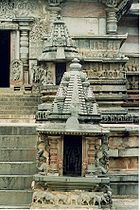
Soapstone
Soapstone is a metamorphic rock, a talc-schist. It is largely composed of the mineral talc and is thus rich in magnesium. It is produced by dynamothermal metamorphism and metasomatism, which occurs in the areas where tectonic plates are subducted, changing rocks by heat and pressure, with influx...
) and is essentially a simple Hoysala plan built with extraordinary detail. What differentiates this temple from other Hoysala temples of the same plan is the unusually large size of the basic parts of the temple. The temple is a ekakuta vimana
Vimana (shrine)
Vimana is a term for the tower above the Garbhagriha or Sanctum sanctorum in a Hindu temple.-Architecture:A typical Hindu temple in Dravidian style may have multiple gopurams, typically constructed into multiple walls in tiers around the main shrine...
design (single shrine) of 10.5 m by 10.5 m size. A large vestibule connects the shrine to the mandapa
Mandapa
A mandapa in Indian architecture is a pillared outdoor hall or pavilion for public rituals.-Temple architecture:...
(hall) which is one of the main attractions of the temple. The mandapa
Mandapa
A mandapa in Indian architecture is a pillared outdoor hall or pavilion for public rituals.-Temple architecture:...
has 60 bays. The superstructure (tower) on top of the vimana has been lost over time. The temple is built on a jagati
Jagati (temple)
Jagati is a term used in Indian temple architecture. A Jagati is a raised surface, platform or terrace upon which the temple is placed....
(platform). There is one flight of steps leading to the jagati and another flight of steps to the mantapa. The jagati provides the devotee the opportunity to do a pradakshina
Pradakshina
Pradakshina or Pradakshinam , meaning circumambulation, consists of walking around in a 'circle' as a form of worship in Hindu ceremonies in India. The devotees walk around the sanctum sanctorum, the innermost chamber of the shrine housing the temple deity. It is done around sacred fire , trees and...
(circumambulation) around the temple before entering it. The jagati carefully follows the staggered square design of the mantapa and the star shape of the shrine. The mantapa here was originally an open one. A visitor would have been able to see the ornate pillars of the open mantapa from the platform. The mantapa is perhaps the most magnificent one in all of medieval India. The open mantapa was converted into a closed one after about 50 years, during the Hoysala rule. This was done by erecting walls with pierced window screens. The window screens are on top of 2 m high walls. There are 28 such windows, with star-shaped perforations and bands of foliage, figures and mythological subjects. On one such screen, King Vishnuvardhana and his queen Shanatala Devi are depicted. Another icon depicts the king in a standing posture.
Shrine
The vimana (shrine) is at the back of the mantapa. Each side of the vimana measures 10.5 m and has five vertical sections. Each vertical section comprises a large double storeyed niche in the centre and two heavy pillar like sections on either side. The two pillar-like sections adjoining the niche are rotated about their vertical axis to produce a star-shaped plan for the shrine. The pillar-like section and the niche bear many ornate sculptures, belonging to an earlier style. There are some 60 large sculptures of deities from both Vaishnava and Shaiva faiths. From the shape of the vimana it has been inferred that the tower above it would have been of the BhumijaBhumija (architecture)
Bhumija is a variety of northern Indian Sikhara that is particularly popular in temples of western India, northern Deccan and the Malwa regions in India. It comprises a central latina projection, tapering towards the top on all four faces...
style and not the regular star shaped tower that followed the shape of the vimana. The Bhumija towers, which are intact on the miniature shrines at the entrance of the hall are actually a type of nagara (North Indian) tower, being curvilinear in shape. This shape of tower is quite uncommon in pure dravidian
Dravidian architecture
Dravidian architecture was a style of architecture that emerged thousands of years ago in Southern part of the Indian subcontinent or South India. They consist primarily of pyramid shaped temples called Koils which are dependent on intricate carved stone in order to create a step design consisting...
architecture. The shrine has a life size (about 6 ft) image of Kesava (a form of Vishnu) with four hands. Each hand holds an attribute; the discus (chakra), the mace (gadha), the lotus-flower (padma) and the conch (Shanka), in clockwise direction. The entrance to the shrine is flanked by life size sculptures of door guardians (dvarapalaka).
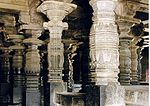
Pillars and Sculptures
The pillars inside the hall are an attraction and the most popular one is the NarasimhaNarasimha
Narasimha or Nrusimha , also spelt as Narasingh and Narasingha, whose name literally translates from Sanskrit as "Man-lion", is an avatar of Vishnu described in the Puranas, Upanishads and other ancient religious texts of Hinduism...
pillar which at one time, it is said, could revolve on its ball bearings. There is a rich diversity about the pillar styles here. While all the 48 pillars are unique and the many ceiling sections are well decorated, nothing surpasses the finish of the four central pillars and the ceiling they support. These pillars may have been hand chiselled while the others were lathe turned. All of these four pillars bear madanikas (Salabhanjika
Salabhanjika
Salabhanjika refers to the sculpture of a woman, displaying stylized feminine features, standing near a tree and grasping a branch. The name of these figures comes from the Sanskrit śālabañjika meaning 'breaking a branch of a sala tree'...
–celestial damsels) and there are 42 of them, 4 inside the hall and the rest outside, between the eaves on the outer walls of the hall. They are also called madanakai, salabanjika or shilabalika and epitomise the ideal female form. They are depicted in various forms, such as dancers, musicians and drummers, and are rarely erotic in nature. Some madanikas that are popular with tourists are the Darpana Sundari (beauty with mirror), "The lady with the parrot", "The huntress" and Bhasma mohini. Other interesting sculptures inside the mantapa are Sthamba buttalika (pillar image) which are more in the Chola style indicating that the Hoysalas may have employed Chola craftsman along with locals. These images have less decor than regular Hoysala sculptures, the mohini pillar being an example.
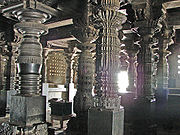
Ramayana
The Ramayana is an ancient Sanskrit epic. It is ascribed to the Hindu sage Valmiki and forms an important part of the Hindu canon , considered to be itihāsa. The Ramayana is one of the two great epics of India and Nepal, the other being the Mahabharata...
and the Mahabharata
Mahabharata
The Mahabharata is one of the two major Sanskrit epics of ancient India and Nepal, the other being the Ramayana. The epic is part of itihasa....
. This style of articulation
Articulation (architecture)
Articulation, in art and architecture, is a method of styling the joints in the formal elements of architectural design. Through degrees of articulation, each part is united with the whole work by means of a joint in such a way that the joined parts are put together in styles ranging from...
is called horizontal treatment with friezes. Hoysala artistry preferred to be discreet about eroticism, mingling miniature erotic sculptures in not so conspicuous places such as recesses and niches. Sculptures depict daily life in a broad sense.
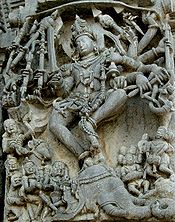
Other important sculptures here are the Narasimha
Narasimha
Narasimha or Nrusimha , also spelt as Narasingh and Narasingha, whose name literally translates from Sanskrit as "Man-lion", is an avatar of Vishnu described in the Puranas, Upanishads and other ancient religious texts of Hinduism...
(a form of Vishnu) image in the south western corner, Shiva-Gajasura
Gajasura
In Hindu mythology, Gajasura is the name used to refer to demon Nila who entered the body of an elephant and attacked Shiva. Shiva, not wanting to hurt the innocent elephant, decided to kill the demon from within the elephant...
(Hindu God Shiva slaying demon in form of elephant) "Gajacharmambaradhari" on the western side, the winged Garuda
Garuda
The Garuda is a large mythical bird or bird-like creature that appears in both Hindu and Buddhist mythology.From an Indian perspective, Garuda is the Hindu name for the constellation Aquila and...
, a consort of God Vishnu standing facing the temple, dancing Kali
Kali
' , also known as ' , is the Hindu goddess associated with power, shakti. The name Kali comes from kāla, which means black, time, death, lord of death, Shiva. Kali means "the black one". Since Shiva is called Kāla - the eternal time, Kālī, his consort, also means "Time" or "Death" . Hence, Kāli is...
, a seated Ganesha
Ganesha
Ganesha , also spelled Ganesa or Ganesh, also known as Ganapati , Vinayaka , and Pillaiyar , is one of the deities best-known and most widely worshipped in the Hindu pantheon. His image is found throughout India and Nepal. Hindu sects worship him regardless of affiliations...
, a boy with an umbrella and a king (the Vamana
Vamana
Vamana is described in the Puranic texts of Hinduism as the Fifth Avatar of Vishnu, and the first incarnation of the Second Age, or the Treta yuga. Also he is the first Avatar of Vishnu which appears with a completely human form, though it was that of a dwarf brahmin. He is also sometimes known as...
Avatar
Avatar
In Hinduism, an avatar is a deliberate descent of a deity to earth, or a descent of the Supreme Being and is mostly translated into English as "incarnation," but more accurately as "appearance" or "manifestation"....
or incarnation of Vishnu), Ravana
Ravana
' is the primary antagonist character of the Hindu legend, the Ramayana; who is the great king of Lanka. In the classic text, he is mainly depicted negatively, kidnapping Rama's wife Sita, to claim vengeance on Rama and his brother Lakshmana for having cut off the nose of his sister...
shaking Mount Kailash
Mount Kailash
Mount Kailash is a peak in the Gangdisê Mountains, which are part of the Himalayas in Tibet...
, Durga
Durga
For the 1985 Hindi Film of Rajesh Khanna see DurgaaIn Hinduism, Durga ; ; meaning "the inaccessible" or "the invincible"; , durga) or Maa Durga "one who can redeem in situations of utmost distress" is a form of Devi, the supremely radiant goddess, depicted as having eighteen arms, riding a lion...
slaying demon Mahishasura
Mahishasura
In Hindu mythology, Mahishasura was an asura.Mahishasura's father Rambha was king of the asuras, and he once fell in love with a water buffalo ; Mahishasura was born out of this union...
, standing Brahma
Brahma
Brahma is the Hindu god of creation and one of the Trimurti, the others being Vishnu and Shiva. According to the Brahma Purana, he is the father of Mānu, and from Mānu all human beings are descended. In the Ramayana and the...
, Varaha
Varaha
Varaha is the third Avatar of the Hindu Godhead Vishnu, in the form of a Boar. He appeared in order to defeat Hiranyaksha, a demon who had taken the Earth and carried it to the bottom of what is described as the cosmic ocean in the story. The battle between Varaha and Hiranyaksha is believed to...
(avatar of Vishnu), Shiva dancing on demon (Andhakasura), Bhairava
Bhairava
Bhairava , sometimes known as Bhairo or Bhairon or Bhairadya or Bheruji , Kaala Bhairavar or Vairavar , is the fierce manifestation of Lord Shiva associated with annihilation...
(avatar of Shiva), Arjuna
Arjuna
Arjuna in Indian mythology is the greatest warrior on earth and is one of the Pandavas, the heroes of the Hindu epic Mahābhārata. Arjuna, whose name means 'bright', 'shining', 'white' or 'silver' Arjuna (Devanagari: अर्जुन, Thai: อรชุน, Orachun, Tamil: Arjunan, Indonesian and Javanese: Harjuna,...
shooting the fish seeing its reflection and the Sun God Surya
Surya
Surya Suraya or Phra Athit is the chief solar deity in Hinduism, one of the Adityas, son of Kasyapa and one of his wives, Aditi; of Indra; or of Dyaus Pitar . The term Surya also refers to the Sun, in general. Surya has hair and arms of gold...
. The sculptural style of the wall images bear similarities with wall sculptures in contemporary temples of northern Karnataka and adjacent Maharashtra.
Artists
The Hoysala artists, unlike other medieval artists, preferred to sign their work in the form of inscriptions. In doing so, they sometimes revealed fascinating details about themselves, their families, guilds and place of origin. Stone inscriptions and copper plate inscriptionsIndian copper plate inscriptions
Indian copper plate inscriptions play an important role in the reconstruction of the history of India. Prior to their discovery, historians were forced to rely on ambiguous archaeological findings such as religious text of uncertain origin and interpretations of bits of surviving traditions,...
provide more information about them. Ruvari Mallitamma was a prolific artist to whom more than 40 sculptures are attributed. Dasoja and his son Chavana who were from Balligavi
Balligavi
Balligavi a town in Shikaripura taluk Shimoga district of Karnataka state, India, is today known as Belagami or Balagame. Its ancient names are Dakshina Kedara,Valliggame and Valligrame. Dakshina Kedara means Kedarnath of the South. A place of antiquity, it is known for its ancient monuments...
in modern Shimoga district
Shimoga District
Shimoga District is a district in the Karnataka state of India. A major part of Shimoga District lies in the Malnad region of the Western Ghats, a hilly area known for its green forests, plentiful rainfall, and as the source of many of the area's rivers. Shimoga City is the administrative centre...
made important contributions. Chavana is credited with the work on five madanikas and Dasoja with four. Malliyanna and Nagoja created birds and animals in their sculptures. Artists such as Chikkahampa and Malloja are credited with some of the sculptures in the mantapa.

